Events Calendar
Current Weather
Winter Finch Forecast 2017-2018
Ever wondered why birds are common in some winters and seem absent in other years? The answer is food...
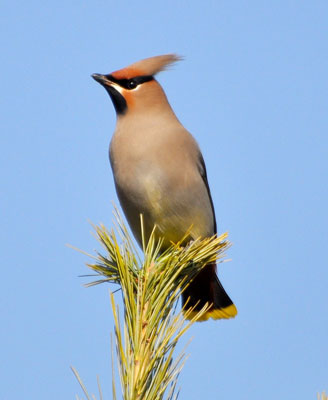 Many winter bird species are nomadic moving to areas with abundant food supplies. Ornithologists (or bird scientists) call this behaviour "irruptive". These irruptive bird species travel the continent in search of specific species of tree seeds and fruit in order to survive winter. In some years birds are abundant and in others they are absent.
Many winter bird species are nomadic moving to areas with abundant food supplies. Ornithologists (or bird scientists) call this behaviour "irruptive". These irruptive bird species travel the continent in search of specific species of tree seeds and fruit in order to survive winter. In some years birds are abundant and in others they are absent.
Ron Pittaway, former Algonquin Park Naturalist (1971-1980) and recipient of the Distinguished Ornithologist Award from the Ontario Field Ornithologists, has been predicting which winter finches will irrupt into southern areas based upon current seed crop production across North America for many years. Learn more about which tree species have produced seed and fruit, and what bird species are expected to irrupt into Algonquin Park.
General Forecast
Cone crops in the Northeast are bumper in 2017. It is the best cone crop in a decade or more. This will be a banner winter to see boreal finches in central and northeastern Ontario, Quebec, Atlantic Canada, northern New York, and northern New England States. White-winged and Red Crossbills and Pine Siskins have moved east to areas of abundant seed crops. The Big Question is: will finches concentrate in areas of highest cone abundance (more likely) or be spread out across the Northeast? This is not an irruption year south of traditional wintering areas in the Northeast. Cone crops are generally low west of a line from Lake Superior to James Bay extending west across the Prairie Provinces, British Columbia and Alaska. See individual finch forecasts below for further details.
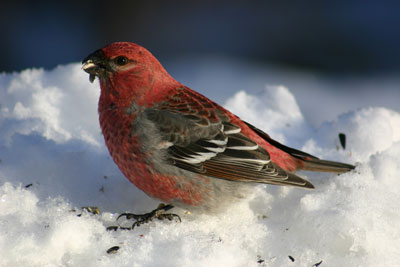 Pine Grosbeak: Most should stay in the north because the mountain-ash berry crop is good to excellent across the boreal forest from Alaska to Newfoundland. Some should get south to Algonquin Park. At feeders they prefer black oil sunflower seeds.
Pine Grosbeak: Most should stay in the north because the mountain-ash berry crop is good to excellent across the boreal forest from Alaska to Newfoundland. Some should get south to Algonquin Park. At feeders they prefer black oil sunflower seeds.
Purple Finch: Most Purple Finches east of Lake Superior should stay north this winter because of heavy seed crops on eastern conifers and mountain-ashes. They prefer black oil sunflower seeds at feeders.
Red Crossbill: There will be a good showing of Red Crossbills in Ontario and the Northeast this winter. Red Crossbills comprise about 10 "call types" in North America. Matt Young of The Cornell Lab of Ornithology reports that Eastern Type 10 is currently the most common type from the Great Lakes through Ontario into the Maritime Provinces and Northeastern United States. This year Matt also reports that Type 2, Type 3 and Type 4 and a few Type 5s from the west are moving east, the latter is a vagrant east of the Rockies. This movement started in late June/early July, presumably linked to poor or failed crops on several conifers in the western U.S. and Canada. Most types are impossible to identify without analyzing recordings of their flight calls. Recordings can be made with an iPhone and identified to call type by audio spectrographic analysis. Matt Young (may6 at cornell.edu) will identify types for you if you email him your recordings or upload them to an eBird checklist. This helps his research. He is particularly interested in recordings from Maine, Vermont, Michigan, Ontario and the Maritime Provinces. Red Crossbills probably will be breeding this winter into next spring. Expect to hear them singing and to see streaked juveniles.
White-winged Crossbill: This crossbill flooded into the Northeast over the summer, drawn here by the bumper cone crops. Winter trips to hotspots such as Algonquin Park, Laurentians and Adirondacks are guaranteed to see this crossbill. They probably will be breeding this fall and winter. Watch and listen for their loud trilling songs given from tree tops and during circular slow-flapping display flights. Expect to see streaked juveniles in the flocks.
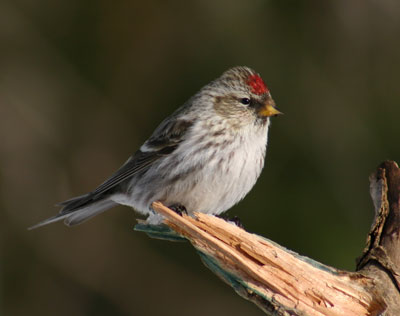 Common Redpoll: Redpolls should move south because White Birch and alder seed crops are below average in northern Ontario. However, as redpolls move south they likely will be slowed or stopped by abundant conifer seed crops and better birch crops. If they get into southern Ontario south of latitude 45, good seed crops on birches and European Black Alder, and an abundance of weedy fields this year will attract them. When redpolls discover your nyger seed feeders, feeding frenzies result. Feeders are best for studying fidgety redpolls. Watch for the larger and darker “Greater” Common Redpoll (subspecies rostrata) from Baffin Island (Nunavut) and Greenland.
Common Redpoll: Redpolls should move south because White Birch and alder seed crops are below average in northern Ontario. However, as redpolls move south they likely will be slowed or stopped by abundant conifer seed crops and better birch crops. If they get into southern Ontario south of latitude 45, good seed crops on birches and European Black Alder, and an abundance of weedy fields this year will attract them. When redpolls discover your nyger seed feeders, feeding frenzies result. Feeders are best for studying fidgety redpolls. Watch for the larger and darker “Greater” Common Redpoll (subspecies rostrata) from Baffin Island (Nunavut) and Greenland.
Hoary Redpoll: Watch for Hoaries in flocks of Common Redpolls. The “Southern” Hoary Redpoll (nominate subspecies exilipes) breeds south to northern Ontario and is the subspecies usually seen in southern Canada and northern USA. Watch for “Hornemann’s” Hoary Redpoll (nominate hornemanni) from northern Nunavut and Greenland. It is the largest and palest of the redpolls. Hornemann’s was formerly considered a great rarity south of the tundra, but recently it has been documented in the south more frequently with better photos. See link #2 for photos and identification of Common and Hoary Redpoll, and their subspecies.
Pine Siskin: Siskins will be frequent and locally common this winter in the Northeast drawn here by abundant cone crops, particularly on White Spruce. Feisty siskins prefer nyger seeds in silo feeders. See link #3 which discusses siskin irruptions related to climate variability.
Evening Grosbeak: Most should stay in the north this winter because of abundant conifer seed crops and increasing outbreaks of spruce budworm. The most reliable spot to see this spectacular grosbeak is the feeders at the Visitor Centre in Algonquin Park. In 2016 the Committee on the Status of Endangered Wildlife in Canada (COSEWIC) assigned the “Evening Grosbeak as a species of Special Concern due to strong population declines occurring mainly in central and eastern Canada.”
Three Irruptive Passerines
Movements of these three passerines are often linked to movements of boreal finches.
Blue Jay: Expect a much smaller than usual flight of jays from mid-September to mid-October along the north shorelines of Lake Ontario and Lake Erie. The acorn, beechnut, hazelnut and berry crops are generally good in Ontario.
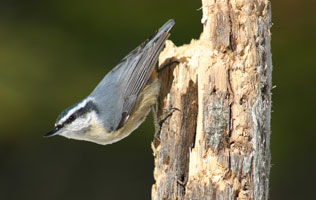 Red-breasted Nuthatch: This nuthatch is now in areas with high cone abundance. Its presence indicates that White-winged and Red Crossbills, Pine Siskins and Purple Finches will be in the same areas.
Red-breasted Nuthatch: This nuthatch is now in areas with high cone abundance. Its presence indicates that White-winged and Red Crossbills, Pine Siskins and Purple Finches will be in the same areas.
Bohemian Waxwing: Only a small flight south is expected because native Mountain-ashes have good to excellent berry crops across the boreal forest from Alaska to Newfoundland. In recent times Bohemians have been coming south more frequently probably due to now reliable annual crops of introduced Buckthorn berries. When they come south, Bohemians relish European Mountain-ash berries and small ornamental crabapples. It was historically called “Bohemian Chatterer” because flocks make a continuous “buzzy ringing twittering”.
Where to See Finches
Ontario’s Algonquin Provincial Park is an exciting winter experience. It is about a 3.5 hour drive north of Toronto and west of Ottawa. Cone crops are excellent in the park so both crossbills, siskins and probably Purple Finches should be common. The bird feeders at the Visitor Centre should attract a few Common Redpolls (watch for Hoaries), Evening and Pine Grosbeaks. The Visitor Centre is open daily during winter, except December 24 - 26, 2017. On weekdays, it is open with limited services (no restaurant, but snacks and drinks are available). To view feeders on weekdays phone 613-637-2828. The Bookstore and Nature Shop has a fine selection of natural history books. Be sure to get Birds of Algonquin Park (2012) by former park naturalist Ron Tozer. It is one of the finest regional bird books. The nearby Spruce Bog Trail and Opeongo Road are the best spots for finches and boreal species such as Canada Jay, Boreal Chickadee, Spruce Grouse and Black-backed Woodpecker. Similarly, the Laurentian Mountains in Quebec and Adirondack Mountains in New York State will be great places to see finches and boreal birds this winter.
Historical Note
Our fascination with nomadic Winter Finches is a long-standing love affair. Here is an edited note titled "Winter Visitors" by A.M. Ross (1873) in The Canadian Ornithologist Vol 1, No 1, Toronto, Ontario. Current names are in brackets. "The past winter was remarkable in the unusual variety of rare northern birds which visited this section of Canada. During the month of January 1873, which was remarkable for the extreme cold and stormy weather, we observed small flocks of Red Crossbills, White-winged Crossbills, Bohemian Chatterers (Bohemian Waxwing), Pine Grosbeaks, Pine Finches (Pine Siskin), Lapland Longspur. Our regular winter visitors also appeared in greater numbers than usual with large flocks of Snow Buntings, Lesser Redpolls (Common Redpoll), Snowbirds (Dark-eyed Junco) and Shore Larks (Horned Lark). The appearance of so many rare northern birds in this section was doubtless owing to the extreme cold weather in northern Canada during last winter." This last sentence is a persisting myth still often repeated to explain the southern occurrences of northern birds in winter. I am grateful to Glenn Coady for bringing this historical reference by Ross (1873) to my attention.
Finch Information Links
- Finch Facts, Seed Crops and Irruptions
- Subspecies of Common and Hoary Redpolls – ID Tips and Photos
- Climatic dipoles drive two principal modes of North American boreal bird irruption
- Interview with Ron Pittaway in OFO News 34(1):1-3, 2016
Acknowledgments
I thank staff of the Ontario Ministry of Natural Resources and Forestry, and the many birders/naturalists whose tree seed reports allow me to make annual forecasts: Christian Artuso (Manitoba), Dennis Barry (Durham Region, Haliburton, Georgian Bay ON), Angus Baptiste (Grand lac Victoria QC), Eleanor Beagan (PEI), Peter Burke, (Southern ON), Geoff Carpentier (Durham Region ON), Glenn Coady (Rainy River ON), Joan Collins (Adirondacks NY), Pascal Côté (Observatoire d'oiseaux de Tadoussac QC), Bruce Di Labio (Eastern ON, Churchill MB), Charity Dobbs (Ontario Tree Seed Plant), Carolle Eady (Dryden ON), Cameron Eckert (Southern YK), Dave Elder (Atikokan ON), Bruce Falls (Brodie Club, Toronto), Marcel Gahbauer (Eastern ON), Bill Gilmour (Presqu’ile Provincial Park ON), Michel Gosselin (Gatineau QC), David Govatski (NH and VT), Leo Heyens (Kenora ON), Tyler Hoar (Southern ON and QC), Kris Ito (French River ON), Jean Iron (James Bay and Northeastern ON), Merven Lane (Northeastern ON), Bruce Mactavish (St. John’s NL), David McCorquodale (Cape Breton Island NS), Rory MacKay (Algonquin Park ON), Ken McKenna (NS), Stacy McNulty (Adirondacks NY), Brian Morin (Cornwall ON), Andree Morneault (Nipissing District ON), Brian Naylor (Nipissing District, ON), Marty Obbard (Peterborough ON), Stephen O’Donnell (Parry Sound District ON), Justin Peter (Algonquin Park ON, Gatineau Park QC, Edmonton AB, Vancouver BC), Fred Pinto (Nipissing District ON), Rosamund and Jim Pojar (Central and Northern BC), Brian Ratcliff (Lake Superior ON), Harvey and Brenda Schmidt (Creighton SK), Doug Tate (Nipigon ON), Ron Tozer (Algonquin Park ON), Declan Troy (AK), Mike Turner (Haliburton Highlands ON), Riley Walsh (Northeastern ON), Richard Welsman (Rosetta McClain Gardens, Toronto). I especially thank Matt Young (NY and Northeastern States) and for sharing his detailed knowledge of crossbills. I thank Michel Gosselin and Jean Iron for proofing the forecast, and Jean hosts the forecast on her website.
About Ron Pittaway
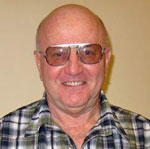 Ron Pittaway’s passion for birds began during the 1950s in Ottawa, where his mentor was the late Earl Godfrey, then Curator of Ornithology at the National Museum. Godfrey influenced Ron’s interest in identification, taxonomy, subspecies, morphs, molts and plumages.
Ron Pittaway’s passion for birds began during the 1950s in Ottawa, where his mentor was the late Earl Godfrey, then Curator of Ornithology at the National Museum. Godfrey influenced Ron’s interest in identification, taxonomy, subspecies, morphs, molts and plumages.
He inspired many people to take up birding during 10 seasons as a Park Naturalist in Algonquin Park and 23 years teaching conservation and resource management science at the Leslie M. Frost Natural Resources Centre.
Ron Pittaway has received the Distinguished Ornithologist Award from Ontario Field Ornithologists (OFO) in 2005 for his outstanding and authoritative contributions to the scientific study of birds in Ontario and Canada.
Related Information
- Current Birding Report
- Birds of Algonquin Provincial Park
- Atlas of the Breeding Birds of Ontario 2007
Reserve your developed or backcountry campsite for your next visit.
Share your passion for Algonquin Park by becoming a member or donor.
Special regulations for Algonquin's special fishery.









